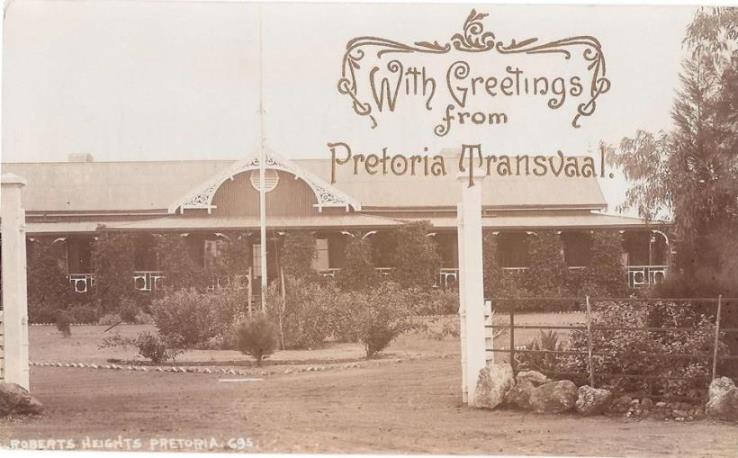
Illustrated above, is a 'REAL PHOTO' postcard published by 'SAPSCo' (South African Photo & Stereo Company) of P.O. Box 5792, Johannesburg. The picture side has been blocked in yellow-gold “With Greetings from Pretoria Transvaal.”; the caption is reversed out in white at lower left 'ROBERTS HEIGHTS PRETORIA. G95.' and it was undoubtedly published between 1909 and 1912. The divided back (address side) is printed in black. The caption does not convey the purpose of the building, but we can see an open gate of which is probably a military establishment. Many of those who bought this postcard, perhaps to use as a Christmas and New Year card, would probably have known exactly where this photograph was taken. It was a nice picture postcard for British troops, based at Roberts Heights, to send to their loved ones 6000 miles away and I doubt if anyone, least of all the Photographer, gave any thought to the possibility that sixty years later it would be branded as propaganda.
Following the First World War, Empires have been criticised once the old world order of the Pax of Empires, which had guaranteed peace to Europe for a hundred years was replaced by a New World Order; the broken reed of the League of Nations. Following the Second World War and the independence of India in 1947, the perception of empires was changed and embodied in the United Nations’ Charter, where sovereign nation-states were favoured. By 1961 the Colonial rule which had often resulted in harmony for the indigenous was lost. Thus during the second half of the twentieth century, it became popular to criticise the British Empire1 and picture postcards similar to the one here, or any 'Empire view' was said to be propaganda. This philosophy was taken to critical extremes and defended in 1984 by J. M. MacKenzie in his book Propaganda and Empire: the Manipulation of British Public Opinion2 and on BBC prime time radio. According to MacKenzie, any picture depicting 'Empire' including pictures on biscuit tin lids etc., were “Imperial Propaganda”.
This type of anti-imperialist generalisation overlooked:
The desire of consumers to collect a view,
Photographers’ aim to document their surroundings,
Those wishing to communicate by posting a picture postcard, and
Newspaper and postcard publishers to record an important event as a pictorial record.
Nowadays, this movement finds less support, although during 2010 I visited The British Museum to see an exhibition, 'Impressions of Africa: Money, Medals and Stamps' which mostly displayed banknotes. I concluded from my two visits that anti-imperialist propaganda was still very much alive and I wrote a letter to the Director of The British Museum, Neil MacGregor, complaining of display captions which I considered to be anti-empire. I felt it was their job to present exhibitions as far as possible in an unbiased way and to get the captions right as there were numerous errors. There really is no excuse for such fundamental errors. Moreover, on both occasions I visited the museum to view the exhibition there were hundreds of school children recording notes from the museum’s display labels. Future generations, need to formulate rationale ideas based on study and not on flawed captions in our public funded museums.
Postscript
Writing about an exhibition at The British Museum during 2013, Andrew Lambirth wrote, 'I wish I could advise you not to look at labels, but you probably wouldn't listen and natural curiosity would no doubt get the better of you.4
Notes and References
1 Darwin, J., (2012), Unfinished Empire, The Global Expansion of Britain, Penguin Books, London, p.3.
2 MacKenzie, J. M., (1984), Propaganda and Empire: the Manipulation of British Public Opinion1880-1960 , Manchester University Press, passim.
3 Impressions of Africa: Money, Medals and Stamps (1st April, 2010 to 6th February, 2011) in room 69a.The British Museum displayed images of Africa: coins, banknotes, medals, stamps and seals made for the continent of Africa during the previous one hundred years.
4 Lambirth, A., 'Exhibitions, Buried treasures', The Spectator, 13th April 2013, p.51.
Copyright © The author 2020 and 2025
- - o - -